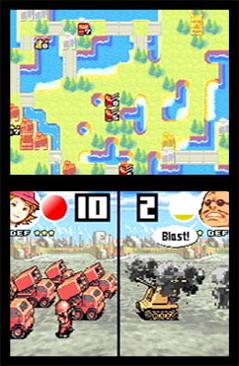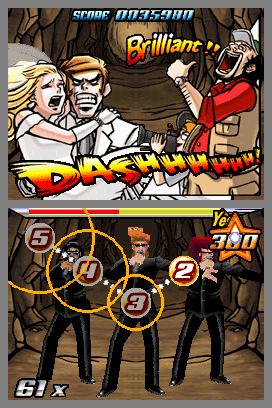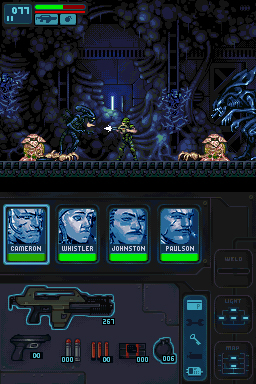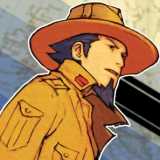The Long Goodbye
By majormitch 22 Comments
Ever since I got my Nintendo 3DS a few months ago, I’ve been thinking a lot about the original Nintendo DS, its legacy and what it’s meant to me personally. After realizing that’s it’s pretty easily among my favorite systems I’ve ever owned, I decided to write this article as a tribute to a great system that’s on its way out. So here’s to you, Nintendo DS. It’s been fun.
When the Nintendo DS came out in late 2004 I was among the early skeptics who weren’t quite sold on the dual and touch screen ideas. My Game Boy Advance worked fine with just one screen and buttons after all, and with titles like The Legend of Zelda: The Minish Cap and Fire Emblem: The Sacred Stones coming out in 2005 (after the DS was already out) there still seemed to be plenty of life left in the old guard. My curiosity got the better of me later that year, however, and a strong Fall 2005 push from the DS led to me picking the system up.

My initial skepticism was quickly proven to be completely unfounded. Looking back, the Nintendo DS had a highly impressive lineup of games during its first full year on the market. Games released for the DS in 2005 include (though are certainly not limited to) Kirby: Canvas Curse, Meteos, Advance Wars: Dual Strike, Castlevania: Dawn of Sorrow, Trauma Center: Under the Knife, Phoenix Wright: Ace Attorney and Mario Kart DS. I played and really liked each of these games, and even better was that they offered a wide variety of experiences that were all perfectly suited for the DS’ portable nature and unique characteristics. Games like Advance Wars: Dual Strike, Castlevania: Dawn of Sorrow and Mario Kart DS showed that classic franchises could work just as well on the DS as they ever have on any other platform. In fact, it could be argued that these three games in particular were among the best in their respective franchises. They certainly played just as well as ever, and looked and sounded as good too. They also made simple but welcome uses of the system’s second screen; I don’t think anyone would complain about having a second screen dedicated to your map in Castlevania for example.
Perhaps more intriguing were the less traditional games among this group, such as Kirby: Canvas Curse, Meteos and Trauma Center: Under the Knife. All of these games relied heavily on the Nintendo DS’ other big introduction, the touch screen, and the results were fantastic. All three games played surprisingly well, showing how precise the touch screen could be as well as how it could allow for drastically different play experiences. The touch screen could clearly allow for more freeform, precision based gameplay than traditional controls could ever offer, and this turned out to be a big part of the DS’ success. Finally, games like Phoenix Wright: Ace Attorney gave us a glimpse as how varied the DS library would ultimately become. It kicked off the great adventure game rebirth that only widened the DS’ appeal, and the genre hasn’t been done nearly as well anywhere else in quite some time. Plenty of other niche genres found similarly cozy homes on the DS, and the variety of the system’s library is easily one of its best traits.

That was all a whopping seven to eight years ago, but that initial batch of games turned out to be a surprisingly strong indicator of just what kind of a system the Nintendo DS would become. Since then the DS has seen dozens of fantastic games that run the gamut: New Super Mario Bros., Elite Beat Agents, a pair of Picross games, The Legend of Zelda: Phantom Hourglass, numerous Professor Layton games, The World Ends With You, Rhythm Heaven, Mario & Luigi: Bowser’s Inside Story, 999: Nine Hours, Nine Persons, Nine Doors, and two full generations of Pokemon. These are only among the many highlights (and also exclude important games like Nintendogs and Brain Age, which don’t interest me personally), showcasing the absolute best that the system has to offer in terms of both pure quality and sheer variety. Every system has their stalwarts though, and what’s equally impressive to me is how the DS has a large, deep library of “mid-tier” games that are entirely worth playing on their own merits. Games like Lunar Knights, Radiant Historia and Aliens: Infestation probably wouldn’t be given the time of day on most platforms, but they shine bright on the DS. I even had a lot of fun playing Dragon Quest Heroes: Rocket Slime; that’s a guilty pleasure game if there ever was one.
What makes a great video game system is something that’s always up for debate, but I’d be willing to bet that almost everyone includes “great games” among their criteria. That in itself can be a subjective process, but I don’t think anyone would argue that the Nintendo DS hasn’t had a fantastic library of games, one that serves just about every corner of the market too. By this measure alone the DS is a great system; among the roughly 15 systems I’ve owned to date I place the DS right near the top. But there’s another trait that’s recently become apparent about the DS, one that might be the purest indicator of a system’s greatness: a refusal to go away. The Nintendo 3DS has been out for over a year, and the DS keeps on going strong in spite of this fact. Games like Okamiden, Pokemon Conquest, and the aforementioned Radiant Historia and Aliens: Infestation all came out around or after the 3DS’ release, and Pokemon Black and White 2 are still on the way. And where Pokemon goes says a lot about a Nintendo handheld’s current status.

Many other great systems have produced the same phenomenon, with the Playstation 2 (notable as the only system in video game history to outsell the Nintendo DS) being perhaps the best example. God of War II and Shin Megami Tensei: Persona 4, a pair of highly successful and wildly popular games, came out after the Playstation 3 was already on shelves. What’s impressive is that these late comers can often be extremely good, and can rival the best from other, newer systems. A small but telling example: The other week I was playing a pair of games simultaneously, Darksiders II and Aliens: Infestation. The former represents a hot new release on current, dominant platforms, and is one of the summer’s biggest titles. The latter is a year old game on a nearly eight year old handheld, but it’s the one I enjoyed substantially more between the two. Since then I’ve picked up and started playing Pokemon Conquest, and have been enjoying that more than I reasonably should as well. I can’t quite put my finger on it, but there remains a certain charm to the DS that’s comforting. It’s kind of like catching up with an old friend, one that you’ve had countless good times with over the years.
The Nintendo 3DS may be out and gathering steam, and popular consoles like the Xbox 360 and Playstation 3 are building up for another big Fall push, but for the time being I still find myself attracted to the original Nintendo DS just as strongly as ever. Whether I’m booting up an old favorite or digging into a gem I missed along the way, the DS is taking its sweet time leaving the spotlight. I’m totally okay with that too; sometimes it can be hard to say goodbye, especially to the great ones.
